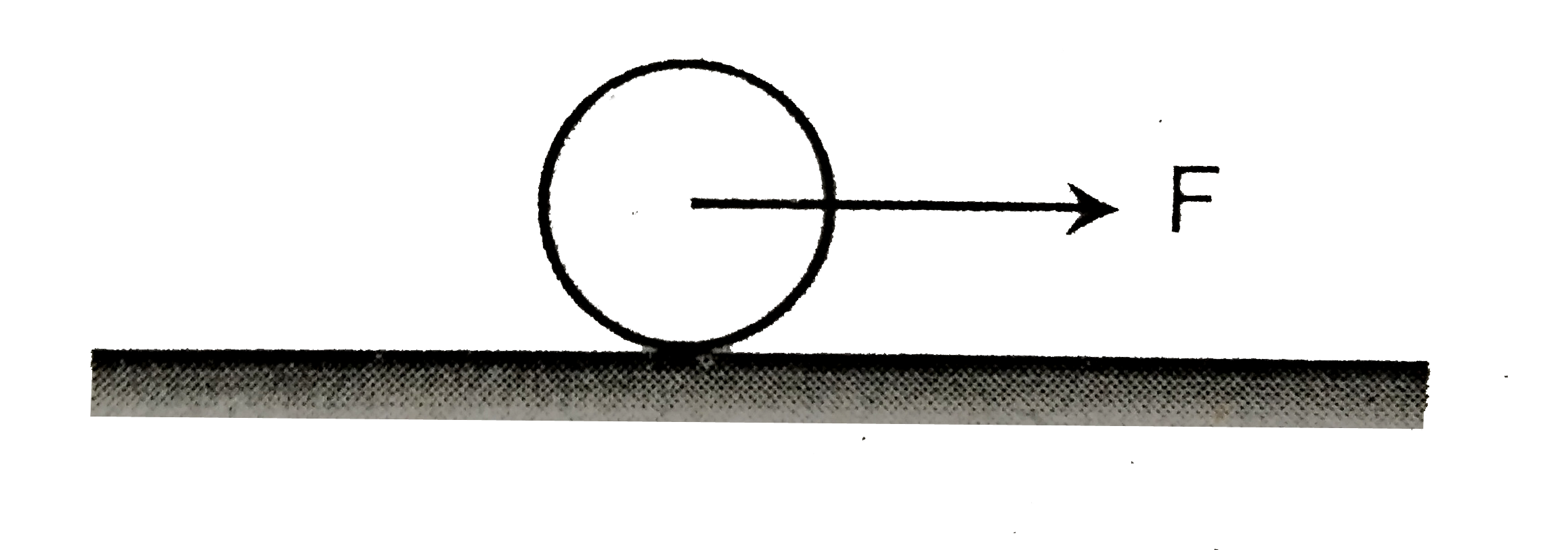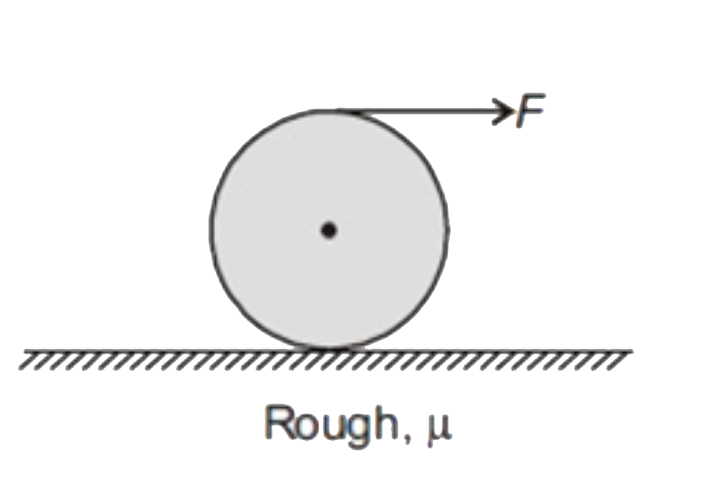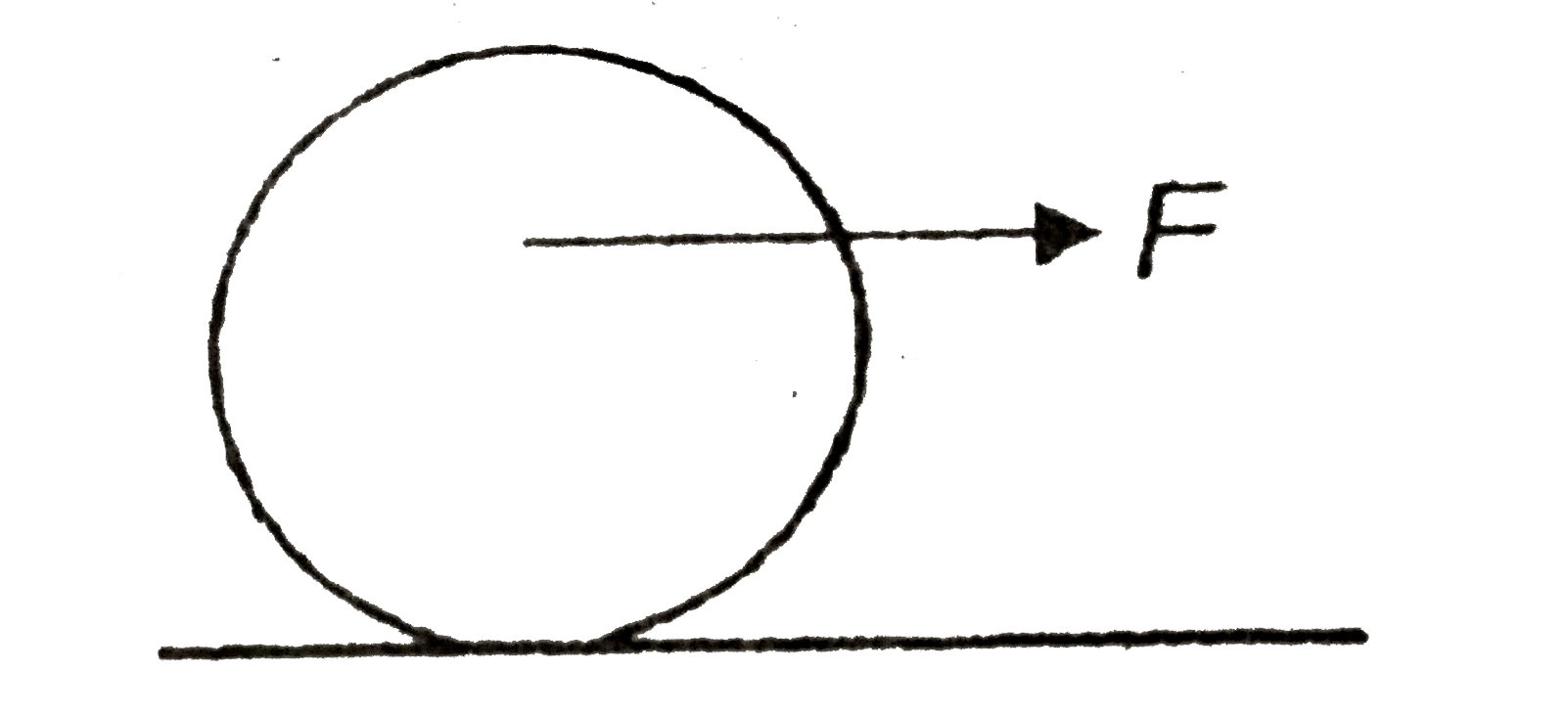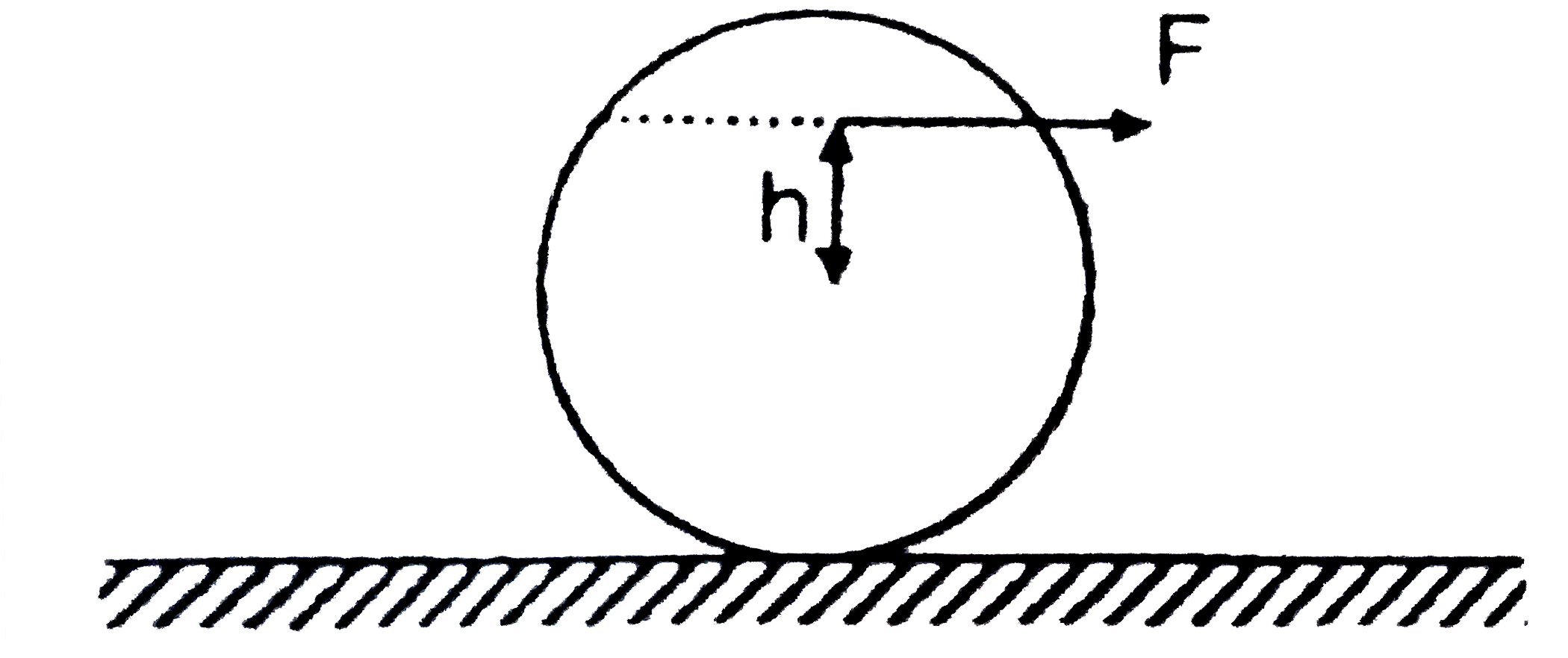A solid cylinder wheel of mass M and radius R is pulled by a force F applied to the centre of the wheel at 37∘ to the horizontal. If the wheel is to roll without slipping, what is the maximum value of |F| ? The coefficients of static and kinetic friction are μs=0.40 and mk=0.30.(sin37∘=35)
To solve the problem of determining the maximum value of the force |F| that can be applied to a solid cylinder wheel of mass M and radius R while ensuring it rolls without slipping, we can follow these steps:
Step 1: Analyze the Forces
The force F is applied at an angle of 37∘ to the horizontal. We can break this force into its horizontal and vertical components:
- Horizontal component: Fx=Fcos(37∘)=F⋅45
- Vertical component: Fy=Fsin(37∘)=F⋅35
Step 2: Write the Equations of Motion
For the wheel to roll without slipping, we need to consider the forces acting on it:
1. Horizontal Direction:
Fx−f=Ma(1)
where f is the frictional force and a is the linear acceleration of the center of mass.
2. Vertical Direction:
N+Fy=Mg(2)
where N is the normal force.
Step 3: Write the Torque Equation
The torque caused by the frictional force about the center of the wheel must equal the moment of inertia times the angular acceleration:
f⋅R=I⋅α
For a solid cylinder, the moment of inertia I is given by 12MR2 and the relationship between linear acceleration a and angular acceleration α is a=Rα. Thus,
f⋅R=12MR2⋅aR
This simplifies to:
f=12Ma(3)
Step 4: Substitute and Solve
Substituting equation (3) into equation (1):
Fx−12Ma=Ma
Substituting Fx:
45F−12Ma=Ma
Rearranging gives:
45F=32Ma
Thus,
F=158Ma(4)
Step 5: Find the Normal Force
From equation (2):
N=Mg−Fy=Mg−35F
Substituting F from equation (4):
N=Mg−35⋅158Ma=Mg−98Ma
Step 6: Maximum Frictional Force
The maximum static friction fmax is given by:
fmax=μsN
Substituting for N:
fmax=μs(Mg−98Ma)
Setting f=12Ma (from equation (3)):
12Ma=μs(Mg−98Ma)
Step 7: Solve for a
Rearranging gives:
12Ma+98Ma=μsMg
Combining terms:
(48+98)Ma=μsMg
138Ma=μsMg
Thus,
a=8μsg13
Step 8: Substitute a Back to Find F
Substituting a back into equation (4):
F=158M⋅8μsg13=15μsMg13
Substituting μs=0.4:
F=15⋅0.4⋅Mg13=6Mg13
Final Answer
Thus, the maximum value of |F| is:
|F|=6Mg13
The force F is applied at an angle of 37∘ to the horizontal. We can break this force into its horizontal and vertical components:
- Horizontal component: Fx=Fcos(37∘)=F⋅45
- Vertical component: Fy=Fsin(37∘)=F⋅35
For the wheel to roll without slipping, we need to consider the forces acting on it:
1. Horizontal Direction:
Fx−f=Ma(1)
where f is the frictional force and a is the linear acceleration of the center of mass.
N+Fy=Mg(2)
where N is the normal force.
The torque caused by the frictional force about the center of the wheel must equal the moment of inertia times the angular acceleration:
f⋅R=I⋅α
For a solid cylinder, the moment of inertia I is given by 12MR2 and the relationship between linear acceleration a and angular acceleration α is a=Rα. Thus,
f⋅R=12MR2⋅aR
This simplifies to:
f=12Ma(3)
Substituting equation (3) into equation (1):
Fx−12Ma=Ma
Substituting Fx:
45F−12Ma=Ma
Rearranging gives:
45F=32Ma
Thus,
F=158Ma(4)
From equation (2):
N=Mg−Fy=Mg−35F
Substituting F from equation (4):
N=Mg−35⋅158Ma=Mg−98Ma
The maximum static friction fmax is given by:
fmax=μsN
Substituting for N:
fmax=μs(Mg−98Ma)
Setting f=12Ma (from equation (3)):
12Ma=μs(Mg−98Ma)
Rearranging gives:
12Ma+98Ma=μsMg
Combining terms:
(48+98)Ma=μsMg
138Ma=μsMg
Thus,
a=8μsg13
Substituting a back into equation (4):
F=158M⋅8μsg13=15μsMg13
Substituting μs=0.4:
F=15⋅0.4⋅Mg13=6Mg13
Thus, the maximum value of |F| is:
|F|=6Mg13
Topper's Solved these Questions
- RIGID BODY DYNAMICS 2BOOK - CENGAGE PHYSICS ENGLISHCHAPTER - RIGID BODY DYNAMICS 2EXERCISE - Exercise 3.4
13 Videos
- RIGID BODY DYNAMICS 2BOOK - CENGAGE PHYSICS ENGLISHCHAPTER - RIGID BODY DYNAMICS 2EXERCISE - Subjective
19 Videos
- RIGID BODY DYNAMICS 2BOOK - CENGAGE PHYSICS ENGLISHCHAPTER - RIGID BODY DYNAMICS 2EXERCISE - Exercise 3.2
13 Videos
- RIGID BODY DYNAMICS 1BOOK - CENGAGE PHYSICS ENGLISHCHAPTER - RIGID BODY DYNAMICS 1EXERCISE - Integer
11 Videos
- SOUND WAVES AND DOPPLER EFFECTBOOK - CENGAGE PHYSICS ENGLISHCHAPTER - SOUND WAVES AND DOPPLER EFFECTEXERCISE - Integer
16 Videos
Similar Questions

A uniform solid cylinder having mass M and radius R is pulled by a horiozntal force F acting through the center as shown. The cylinder rolls to the right without slipping. What is the magnitude of the force of friction between the cylinder and the ground?
View SolutionA solid sphere of mass M and radius R is pulled by a force F as shown in figure . If the sphere does not slip over the surface , then frictional force acting on the sphere is

View Solution
Knowledge Check
A solid cylinder of mass M and radius R rolls down an inclined plane without slipping. THE speed of its centre of mass when it reaches the bottom is
A√(2gh)B√4/3.ghC√3/4.ghD√(4g/h)A solid cylinder of mass M and radius R rolls without slipping down an inclined plane making an angle 6 with the horizontal. Then its acceleration is.
A1/3 g sinθB2/3 g sinθC2/5 g sinθD2/7 g sinθ
A force (F=Mg) is applied on the top of a circular ring of mass M and radius R kept on a rough horizontal surface. If the ring rolls without slipping, then minimum coefficient of friction required is
_PHY_E05_236_Q01.png)
View SolutionA homogeneous cylinder of mass Mand radius r is pulled on a horizontal plane by a horizontal force F acting through its centre of mass. Assuming rolling without slipping, find the angular acceleration of the cylinder,
View SolutionA homogeneous cylinder of mass Mand radius r is pulled on a horizontal plane by a horizontal force F acting through its centre of mass. Assuming rolling without slipping, find the angular acceleration of the cylinder,
View SolutionOn an uniform cylinder of mass m and radius R a constant horizontal force F is applied at any point. Choose the correct alternative if cylinder is rolling without slipping in rightward direction

View SolutionA solid cylinder of mass M and radius R rolls down an inclined plane of height h without slipping. The speed of its centre when it reaches the bottom is.
View Solution
A solid sphere of mass ma nd radis R is placed on a rough horizontal surface A horizontal force F is applied to sphere at a height h, (0≤h≤R) from centre. If sphere rolls slipping then,
View Solution